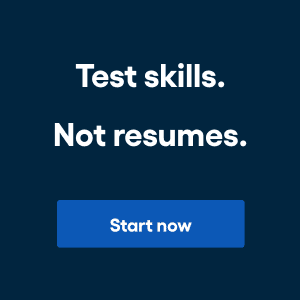Touted as the future of recruitment, skills-based hiring practices not only diversify talent pools, but can also be revolutionary for closing the gender gap.
Despite coming a long way in recent years, gender inequality is still a systemic and deeply rooted issue in workforces around the globe.
According to Payscale’s 2022 State of the Gender Pay Gap Report, women make 83 cents for every $1 earned by their male counterparts, even in scenarios where the job title, education, experience, industry, job level, and hours worked are the same.
Unfortunately, this figure means that we’re still miles off experiencing true gender equality in the workplace, including equal pay, equal opportunity, and equal promotion opportunities. To make matters worse, traditional hiring processes are doing very little to help combat the gender gap.
Achieving authentic diversity and inclusion in the workplace requires a multidisciplinary approach, and often starts at the very bottom of the recruitment funnel.
The good news? A growing number of organizations around the world are using skills-based hiring to help them close the gender gap, and are seeing encouraging results.
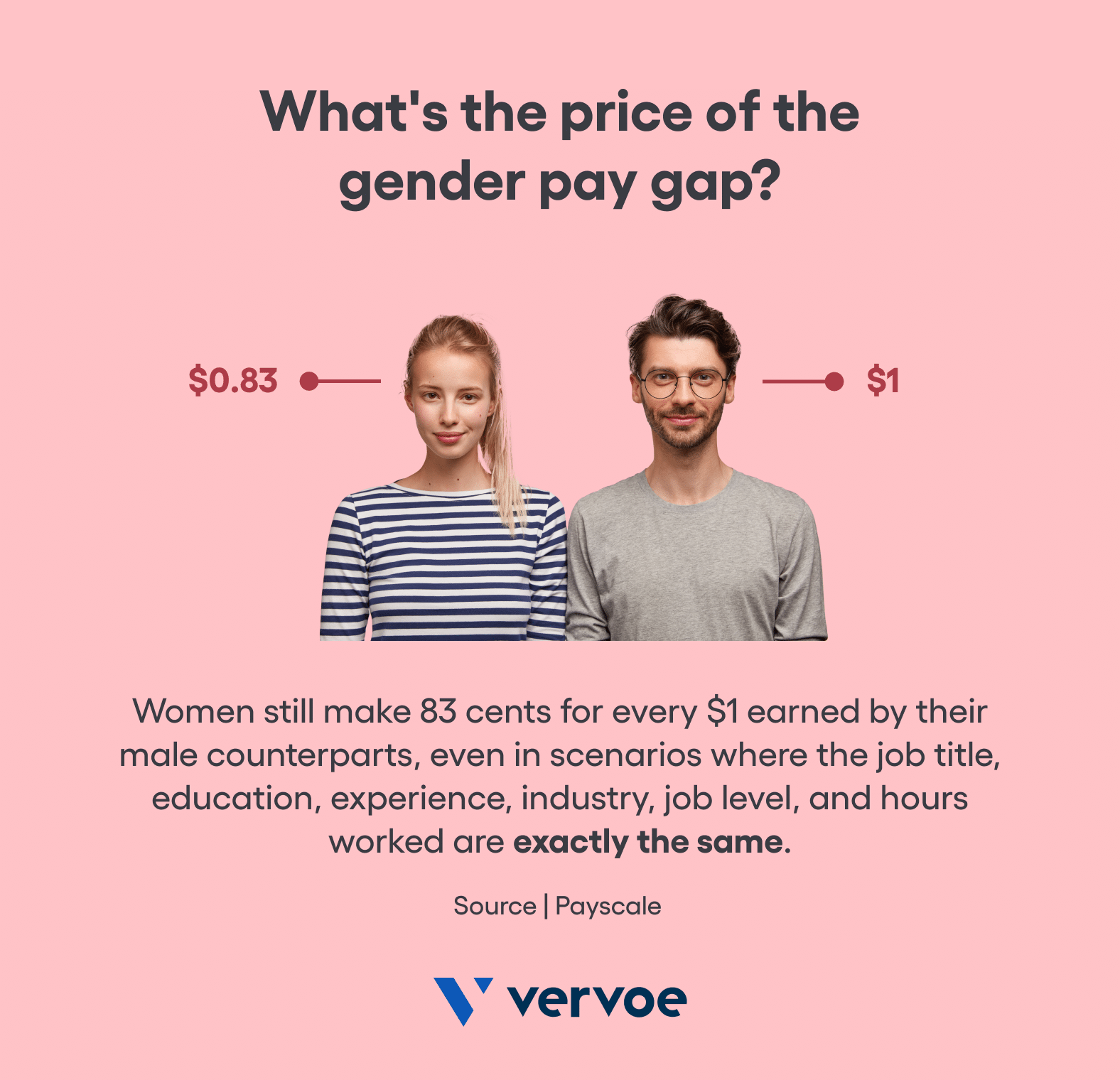
A snapshot of the global gender gap in 2023
Although here’s an untapped resource in the workforce that’s been around for centuries, organizations still aren’t recognizing it’s true potential. Yep, we’re talking about women.
Data collected by Pew Research Center found that women made up the majority of college-educated workers at 50.2% in 2019. Despite being the majority, the gender disparities we continue to witness in the workplace illustrate a frightening future for women in the workforce.
While job types, a lack of workplace flexibility and unconscious bias during the hiring process are all factors that negatively influence a pay based gender gap, it still doesn’t explain why candidates who hold the same degree will earn wildly different salaries, depending on their gender.
According to the United States Census Bureau, a male with a bachelor’s degree earned $71,666 on average. In comparison, a woman – qualified with the exact same degree – would earn $51,154 on average, or 28.62% less per annum.
As has long been the case, the wage gap is smaller for workers aged between 25 to 34, than for all workers 16 and older. In 2022, women aged 25 to 34 earned an average of 92 cents for every dollar earned by a man in the same age group. By comparison, the gender pay gap among workers of all ages that year was 18 cents.
In real world terms, what this means is that the gender gap has narrowed for younger women, particularly as they increase their education level and break into occupations traditionally dominated by men.
While women have a growing presence in higher paying industries like science, management and technical services, they are still over-represented in lower paying industries, which is thought to be why the gender pay gap remains stubbornly high across all age groups.
Unfortunately, the potential for gender based discrimination starts from the moment a position is advertised, and eliminating it requires a multifaceted approach.
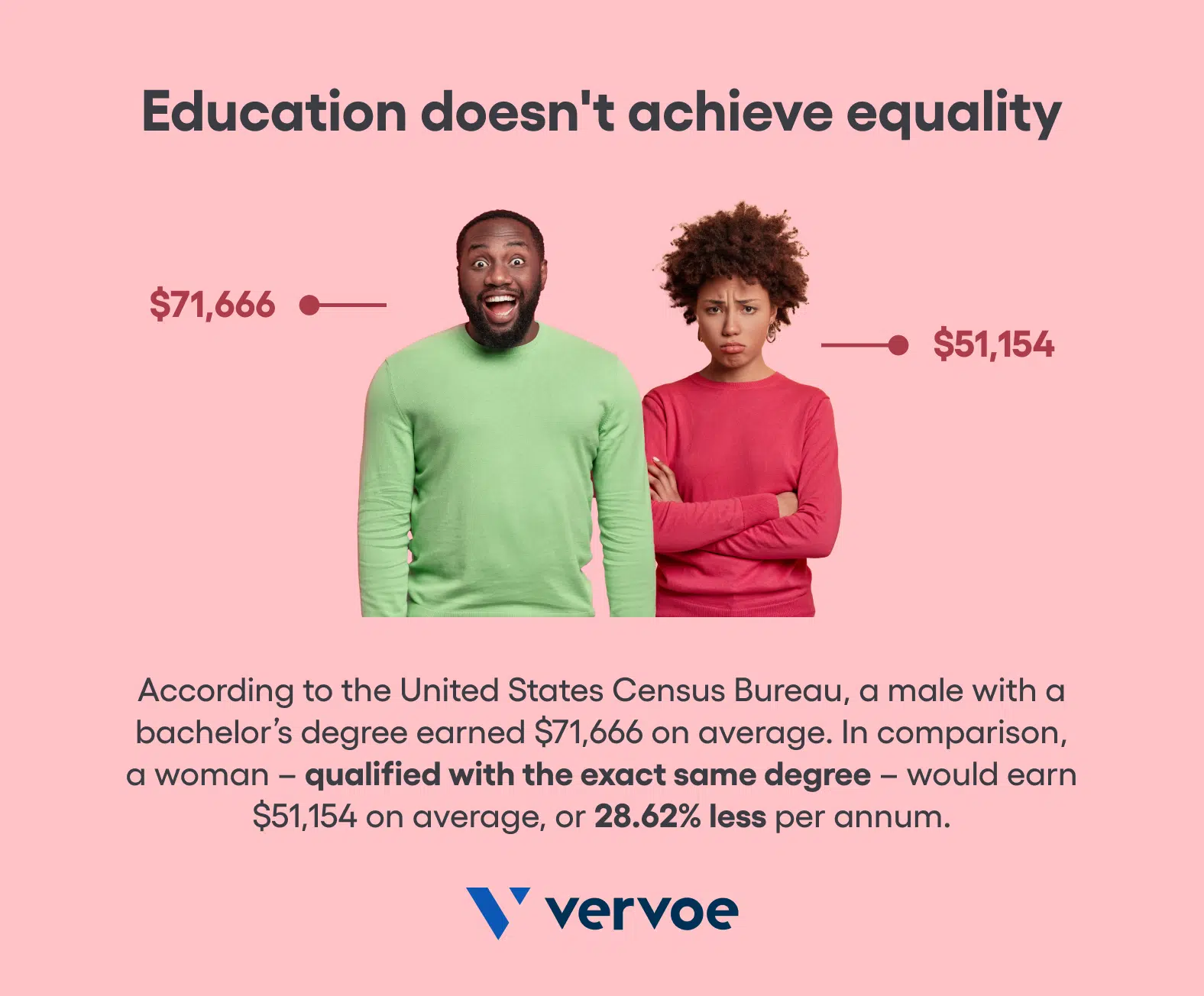
While job types, a lack of workplace flexibility and unconscious bias during the hiring process are all factors that negatively influence a pay based gender gap, it still doesn’t explain why candidates who hold the same degree will earn wildly different salaries, depending on their gender.
How traditional recruitment processes contribute towards the gender gap
While there’s no denying that there’s multitude of reasons contributing to the ongoing impact of the gender gap, there is one obstacle perpetuating inequality in the workforce: the traditional recruitment process, and the conscious and unconscious biases riddled within the hiring funnel.
Every day, talented people are being eliminated from the recruitment process because of their gender – a factor that often has very little influence on their ability to perform the role successfully.
If you’re unfamiliar with the term and how it’s used in recruitment, unconscious bias refers to the opinions formed about a candidate based on belief systems and social stereotypes, rather than solely looking at their skill and suitability for the role.
As an example, a hiring manager may have had a negative experience in the past with a female employee, influencing the way they view all female candidates.
Similarly, stereotypes may come into play where a recruitment manager perceives men to be more analytical and logical than female candidates, despite having the same experience and skill.
In the hiring process, unconscious bias can present itself in various forms, including the language used in job postings (using a feminine or masculine tone in the text), playing into gender stereotypes, assuming suitability or skill set, similarity bias (hiring someone similar to yourself), and more.
According to a UN report, almost 90% of men and women hold some sort of bias against women – meaning that gender discrimination during the recruitment process likely happens much more often than most people think.
Throughout history, we’ve seen favoritism towards men for corporate positions. According to a PNAS study, when provided with a list of equal candidates, men were 1.5 times more likely to be selected over women for the role.
Unfortunately, women also have the odds stacked against them even when they do try to bend gender norms. According to the Employers Council, HHS Public Access and PbMed Central conducted an analysis of 27 studies looking into gender bias in the hiring process.
The findings showed that several interviewers demonstrated negative opinions towards women who behaved in ways deemed more stereotypically masculine, including self-promoting language.
[Read More – Unconscious Bias Examples To Be Aware Of At Your Organization]
Many believe that there are various stereotypes and biases at play when comparing women to men in the workforce, most of which are systemic belief systems.
Consider the following findings from Payscale’s 2022 State of the Gender Gap report, which suggest that women are still expected to work in more ‘nurturing’ roles, such as non-profits (65%), education (69%), and healthcare (76%). On the contrary, men are considered more suitable for problem-solving positions and wealth management.
Due to unconscious biases and gender stereotypes, women are more often funneled into lower paying careers as their work is considered less valuable than men. Like it or not, women are still considered caretakers, and this often impacts their long-term career progression – as is evident in the gender pay gap.
Unfortunately, gender discrimination and bias isn’t just present in the selection process – it’s present throughout a woman’s entire career. The question is, what can organizations do to actively promote gender equality, and future proof their talent pool?
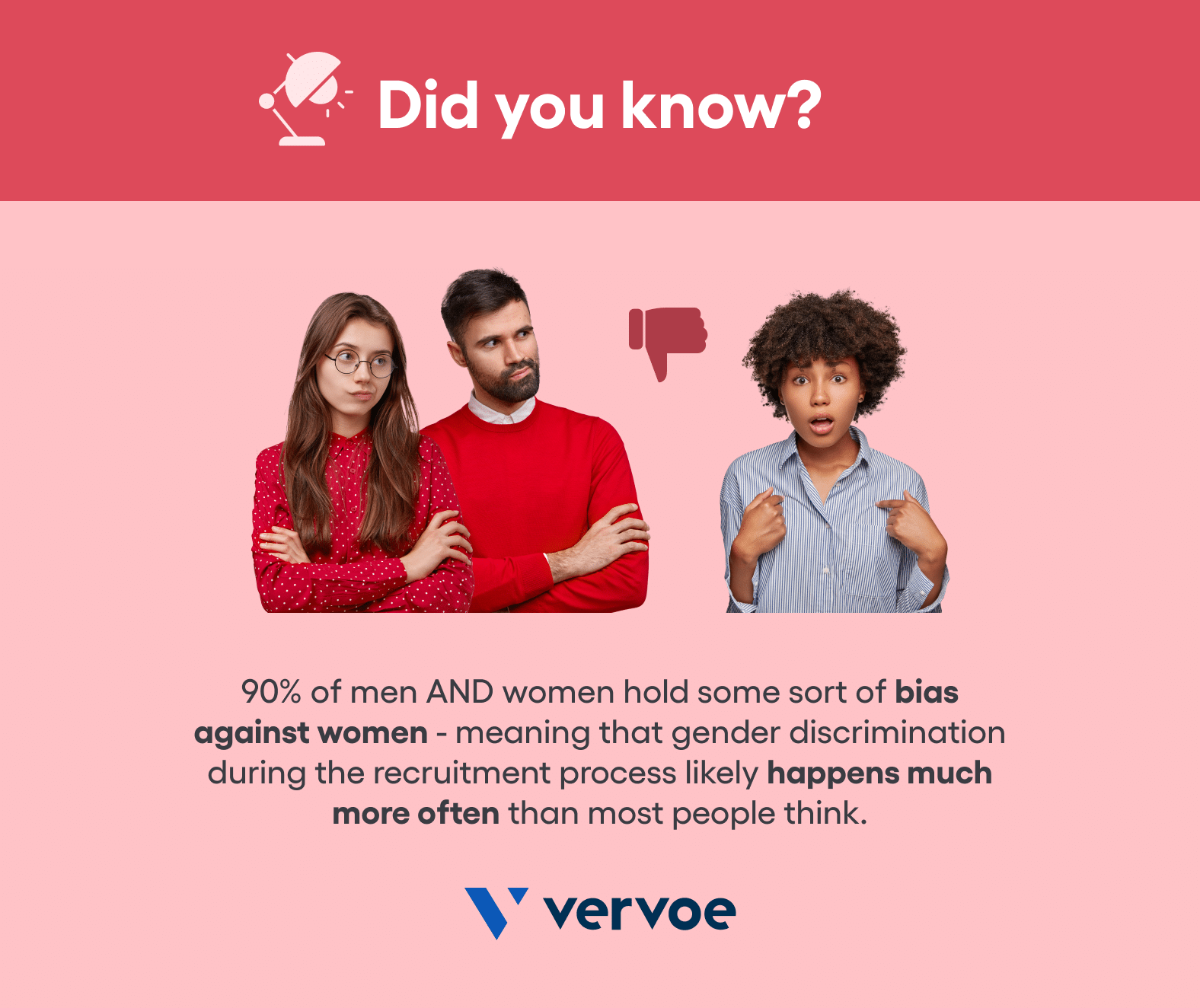
What strategies can be used to promote gender equality?
More often than not, achieving gender equality in the workplace is not a milestone that happens without some careful preparation and planning.
While increasing female labor market participation, ensuring that men and women have the same economic independence, reducing the gender pay, earnings and pension gaps, and promoting equality between women and men in decision-making are all big targets to hit, the first step of achieving diversity in the workplace will usually involve getting back to basics and evaluating your company’s recruitment process.
As gender discrimination often rears its ugly head at the very early stages of hiring, finding a holistic long term strategy to combat this is a must. Thanks to its ability to address this issue – and a wide range of others – skills-based hiring is on the rise.
What is skills-based hiring and how does it work?
Simply put, skills-based hiring is a recruitment approach that hires employees based purely on skills, capabilities, and suitability to the role, as opposed to looking at their educational background, experience, and assumed suitability.
Skills-based hiring assesses a candidate’s soft and hard skills, and aims to unearth the candidate whose skills best align with the responsibilities and duties of the advertised position. The easiest way to implement skill-based hiring is through skills testing, which is otherwise known as an employee skills assessment or skills test.
[Read More – Everything You Need To Know About Skills Testing]
Hiring people based on skills allows recruiters to see if a candidate is truly equipped to do the job, helping them make the best hire the first time around.
While this key feature is appealing for organizations looking to avoid making a bad hire while simultaneously speeding up their recruitment efforts, a skills test will also eliminate the chance of any human biases creeping in – encouraging true gender equality.
In recent years, we’ve seen many global players like Apple, Hilton, Google shift to skills-based hiring practices as a way to guarantee the best candidate for the role, free of bias and assumed suitability.
As the name of the philosophy would suggest, this modern approach to recruitment is based on competencies, skill, and talent, instead of prioritizing background, experience, and formal qualification.
Three ways skills testing can combat the gender gap in the workplace
There are many factors contributing to gender inequality in the workplace. Due to its complex and multifaceted nature, skills-based hiring alone cannot entirely combat the gender gap – but it can certainly help.
Skills-based hiring has a significant impact in reducing the conscious and unconscious biases inherently present in the hiring process, which is thought to be a key contributing factor to women’s lack of presence, responsibility, and opportunities in the workplace.
What’s more, skills-based testing and assessments can help support gender equality in the following ways:
1. AI automation removes human bias
A quality skills-based assessment is reviewed using AI grading, which largely removes human bias from the equation. While what constitutes a “good” and a “bad” answer is pre-determined by a human, AI automation still reduces the gender biases that influence decisions throughout the hiring process – most of which aren’t in favor of female candidates.
This process helps to remove affinity bias (favoring candidates similar to you), confirmation bias ( forming an opinion on a candidate before the interview), contrast effect (comparing two candidates and emphasizing the positive attributes of one), and gender bias ( favoring one gender over another). To achieve this, it’s crucial that a skills test is fed a clean data set with no chance for bias to creep in.
[Read More – Good Ai vs Bad Ai In Recruiting]
2. Candidates are assessed on relevant factors
AI-powered skills testing will rank candidates based on how their soft and hard skills correlate with the requirements and responsibilities of the role. This process removes any unnecessary bias from the recruitment process, whether it be gender, education, experience, age, etc. By assessing a candidate on their skills, it leaves little room to inject stereotypes or biases into the process.
Skill assessments ultimately level the playing field for all candidates. More so than resumes or job interviews, a skills test can assess the true potential of a new hire to go the distance with the company while giving all applicants an equal opportunity to showcase their talents – but this is only the case if the skills test sticks to questions that are relevant to the role.
3. Skills testing encourages workplace diversity
Research shows that skill-testing can help companies overcome unconscious bias and improve diversity hiring. Rather than using shortcuts like education or job titles, skills assessments allow companies to tap into a wider, more diverse talent pool. This is especially relevant for applicants – including women – who possess the necessary tools of the trade, but may not have obtained them via university.
By including candidates who have obtained their trade through alternative education methods, using skills tests can help companies reach their diversity hiring goals, which leads to a whole other host of benefits including increased innovation, productivity, and profitability. Instead of eliminating qualified and skilled candidates, skills testing aims to include them.
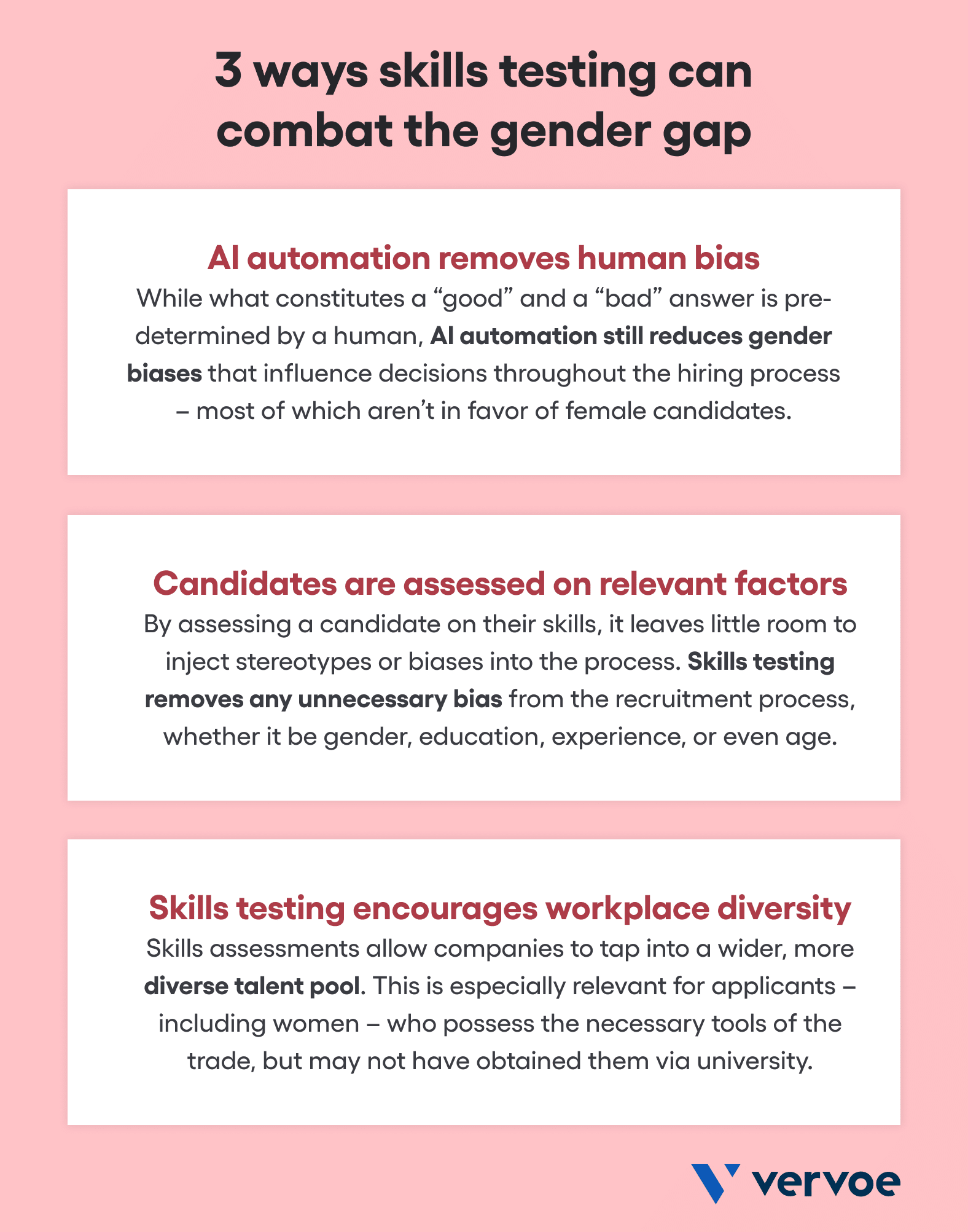
Learn how Vervoe can help your company achieve gender equality
While most organizations and recruiters likely believe their hiring decisions are influenced by factual information, objectivity, and a candidate’s suitability to the role, workplace inequality proves this isn’t necessarily the case.
Vervoe is an end-to-end AI-powered solution that is proudly revolutionizing the hiring process through skills testing, job simulations, and machine learning recruitment.
By empowering businesses to create role specific assessments designed to suit the unique requirements of a position, Vervoe predicts performance through skills-based hiring practices that showcase the talent of every candidate.
Ultimately, our job simulations focus on the work — and not the person. To see people do the job before they get the job, book a demo today and let our experienced team run you through Vervoe’s full range of ready-made and tailored solutions.



